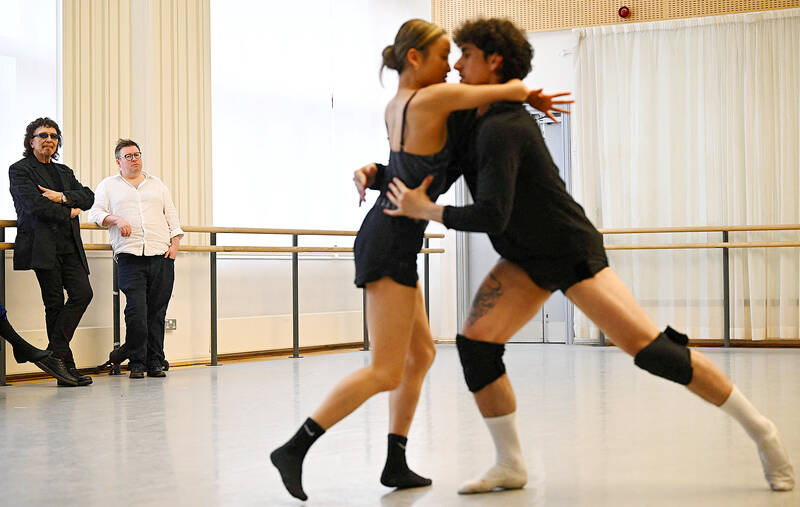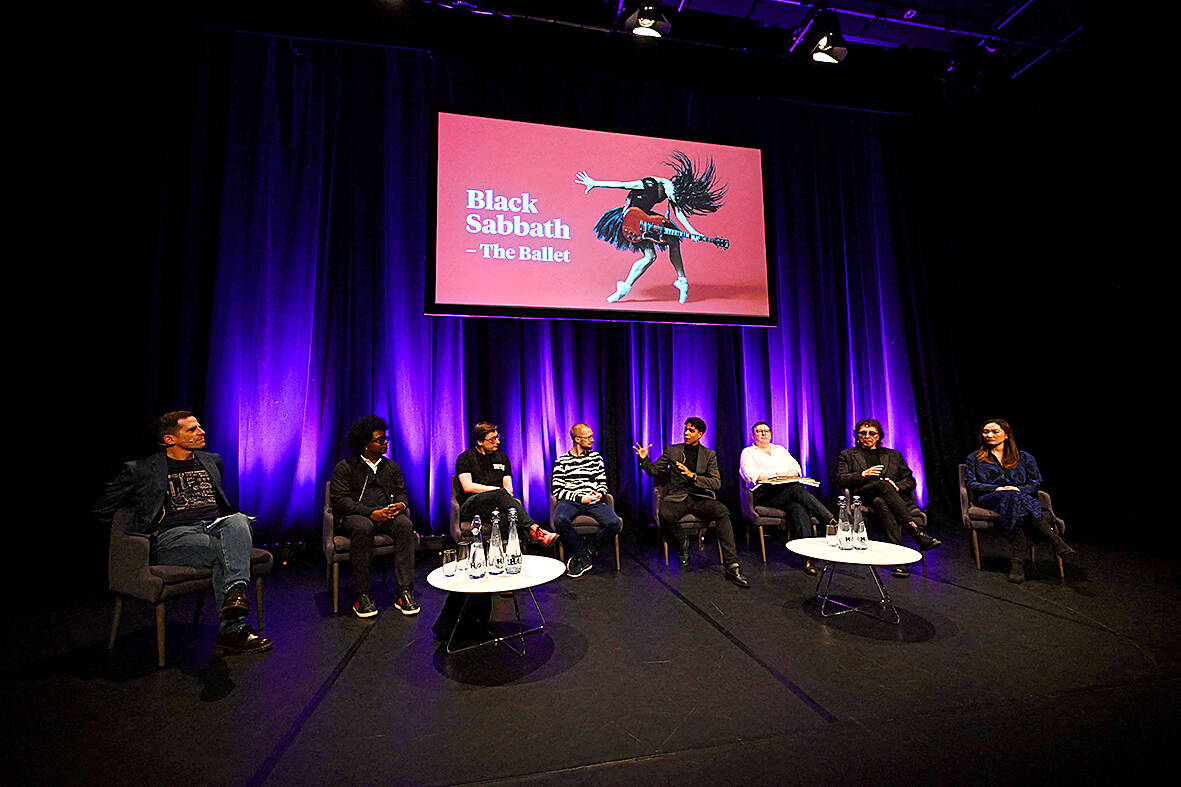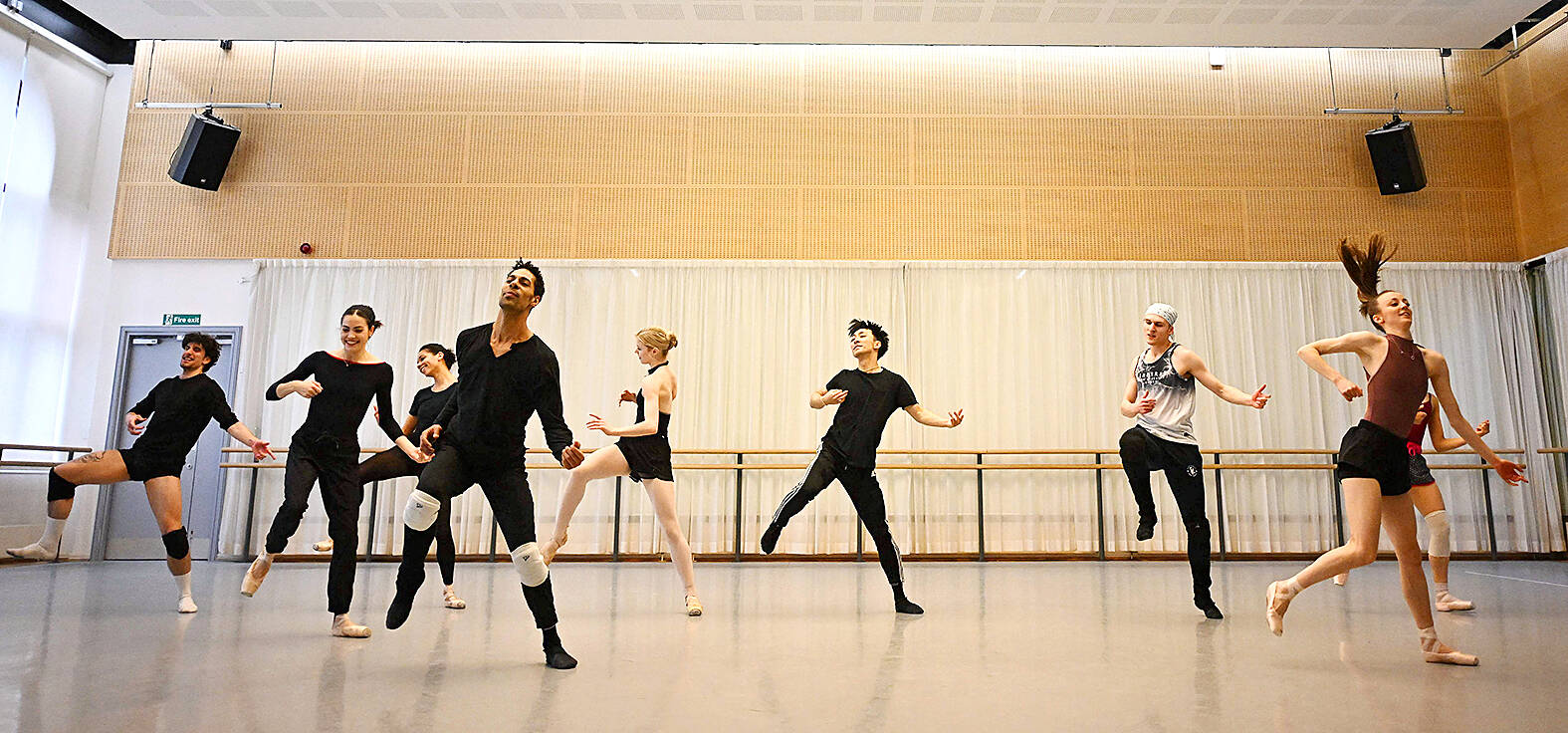In a rehearsal studio in central England, dancers are getting to grips with new, heavy metal-inspired ballet steps. Moving gracefully in unison, they team pirouettes with air guitar, leaps with head banging.
Welcome to Black Sabbath — The Ballet, the brainchild of Cuban dance star Carlos Acosta, artistic director of the Birmingham Royal Ballet.
Determined to celebrate the cultural treasures of the UK’s second city since his arrival in 2020, Acosta took his idea to Black Sabbath co-founder and guitarist Tony Iommi, who gave it his blessing along with the group’s original vocalist Ozzy Osbourne.

Photo: AFP
“I was fascinated with the idea. I thought, ‘How are they going to do that?’” Iommi, 75, said Thursday in Birmingham.
“I just couldn’t imagine how they’d do ballet to Black Sabbath and then I thought, well, maybe they’re going to use the ... softer tracks. But no, they went for Black Sabbath, War Pigs, Iron Man,” he said. “I think I was just really intrigued.”
The full-length, three-act ballet opens in Birmingham, the pioneering group’s home city, in September before going on tour. Rehearsals have just begun.

Photo: AFP
NOT A DOCUMENTARY
According to writer Richard Thomas, the ballet is the “rags-to-riches story” of four young men who went from the “factory floor to one of the most successful bands in rock history,” although he stressed it would not be a documentary set to music and dance.
The legendary group’s original line-up was Osbourne, Iommi, bassist Geezer Butler and drummer Bill Ward.

Photos: AFP
They were instrumental in creating heavy metal in the early 1970s with dark and high-volume guitars coupled with a keen interest in the occult.
“It’s very simple. It’s like Black Sabbath meets the Birmingham Royal Ballet,” Thomas said.
There would, however, be use of archive interviews and also some famous Black Sabbath stories such as how Iommi lost the tips of two fingers in an industrial accident on his last day working at a sheet metal factory.
Also making an appearance will be the tale of the “Stonehenge” set that had to be dumped after a measurements mix-up meant it was so big it wouldn’t fit into auditoriums.
And he said there might “possibly be a brief mention of the bat incident,” in which Osbourne thought a fan had thrown a rubber bat onstage only to discover — after he took a bite — that it was real.
For Acosta, 39, there had been an immediate rapport with Iommi after he first approached him with the project.
“I didn’t know the man (or) how we were going to hit it off, but obviously we both come from the same background in terms of working-class and poor families ... and the chemistry was instant,” he said.
GLORIOUS IRREGULARITY
The former star dancer said he came to the music of Black Sabbath late due to growing up in Cuba.
“I grew up in the 1980s, I wanted to be Michael Jackson. I didn’t know anything about Black Sabbath,” he said, adding that he only discovered the group through a friend in the late 1990s.
“This was the music of those who are marginalized so I found it very interesting,” he adds.
Musically, composer Chris Austin said it had been difficult to know where to start as the Black Sabbath back catalogue was so huge.
But he said once they narrowed it down it had been easy to be inspired by the music’s “glorious irregularity” and “enormous shifts of tempo,” combined with Osbourne’s early “stratospheric” vocals.
The show will be a treat for fans after the group, including three of the original members, ended their last-ever tour with a final concert in Birmingham in 2017.
Iommi said he was as interested as everyone else to discover how the ballet would turn out, but that he had been confident in Acosta and his team from the start.
“I know from our fans that there is a lot of excitement to come to the show,” he said, adding that he expected people would be particularly keen to join in.
“I think it will be great.”

On April 26, The Lancet published a letter from two doctors at Taichung-based China Medical University Hospital (CMUH) warning that “Taiwan’s Health Care System is on the Brink of Collapse.” The authors said that “Years of policy inaction and mismanagement of resources have led to the National Health Insurance system operating under unsustainable conditions.” The pushback was immediate. Errors in the paper were quickly identified and publicized, to discredit the authors (the hospital apologized). CNA reported that CMUH said the letter described Taiwan in 2021 as having 62 nurses per 10,000 people, when the correct number was 78 nurses per 10,000

May 5 to May 11 What started out as friction between Taiwanese students at Taichung First High School and a Japanese head cook escalated dramatically over the first two weeks of May 1927. It began on April 30 when the cook’s wife knew that lotus starch used in that night’s dinner had rat feces in it, but failed to inform staff until the meal was already prepared. The students believed that her silence was intentional, and filed a complaint. The school’s Japanese administrators sided with the cook’s family, dismissing the students as troublemakers and clamping down on their freedoms — with

As Donald Trump’s executive order in March led to the shuttering of Voice of America (VOA) — the global broadcaster whose roots date back to the fight against Nazi propaganda — he quickly attracted support from figures not used to aligning themselves with any US administration. Trump had ordered the US Agency for Global Media, the federal agency that funds VOA and other groups promoting independent journalism overseas, to be “eliminated to the maximum extent consistent with applicable law.” The decision suddenly halted programming in 49 languages to more than 425 million people. In Moscow, Margarita Simonyan, the hardline editor-in-chief of the

Six weeks before I embarked on a research mission in Kyoto, I was sitting alone at a bar counter in Melbourne. Next to me, a woman was bragging loudly to a friend: She, too, was heading to Kyoto, I quickly discerned. Except her trip was in four months. And she’d just pulled an all-nighter booking restaurant reservations. As I snooped on the conversation, I broke out in a sweat, panicking because I’d yet to secure a single table. Then I remembered: Eating well in Japan is absolutely not something to lose sleep over. It’s true that the best-known institutions book up faster